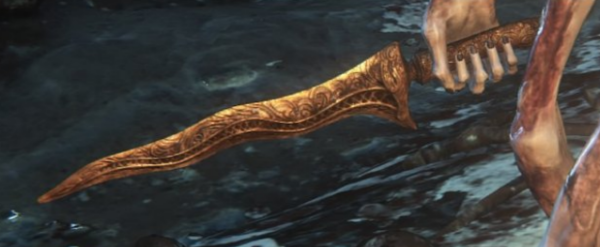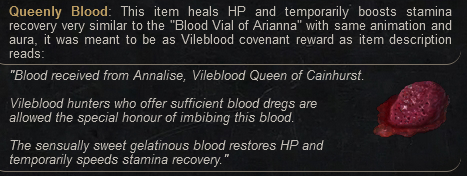in order to make sense of the world of bloodborne, one must first make sense of the from software company “house style” or, at the very least, make an attempt to recognize the recurring themes present in their catalog of RPG titles. each addition has helped refine the central messages core to the ethos of the dev team through repetition. this makes the act of playing fromsoft games sound like a monotonous experience; fromsoft sometimes iterates in expected and annoying ways: there will always be a poison swamp, there will always be a shoeless babe, there will always be a guy waiting to kick you into a hole. but their means of obfuscating or re-framing these ideas are imaginative. a transformation into a plant has different implications and intentions depending on the setting; in bloodborne, it’s a desirable outcome caused on purpose to push human evolution beyond its bounds. in dark souls 3, it’s involuntary as part of a means of returning the world to its primordial form. if i told you that dark souls, bloodborne, and sekiro all had the same plot, you’d tell me to shut the hell up and then push me into a ravine. and yet, these games all share one very specific message that acts as the base point for the cruel, dying worlds we explore: if we could re-spawn like in a video game, it would be fucked up or what? bloodborne is no exception.
fromsoft’s creation process involves folding in real-life history and cultural knowledge that i think is lost on the majority of the western player base. i’m not sure how much of what they reference is common knowledge to japanese players, but i do feel confident in saying that bloodborne leans on these references harder than most fromsoft’s games. for example, i can reasonably argue that the history of yharnam began with a meteorite not dissimilar to one that fell in japan that was used to make legendary swords(not unlike the a select few in the game) comprised of meteoric, magnetic iron or siderite. and with the arrival of the cosmos came the discovery of the arcane.

 untold eons ago, a humanoid race known as the pthumerians served slumbering mysterious, otherworldly beings, known as the great ones, “beings that might be described as gods“. the great ones spoke in “inhuman utterings” to those capable or worthy of hearing their speech. those blessed would become stronger and imbued with strange powers. at least one of these voices was successfully transcribed during the course of pthumerian history, as it appears on gravestones, altars, and as decor: “hunter“, a blood rune.
untold eons ago, a humanoid race known as the pthumerians served slumbering mysterious, otherworldly beings, known as the great ones, “beings that might be described as gods“. the great ones spoke in “inhuman utterings” to those capable or worthy of hearing their speech. those blessed would become stronger and imbued with strange powers. at least one of these voices was successfully transcribed during the course of pthumerian history, as it appears on gravestones, altars, and as decor: “hunter“, a blood rune.
as the proliferance of the rune might suggest, pthumeru was a society revolving around the collection of blood. either as a consequence of living underground or due to becoming exposed to the deliberately vague notion of “the eldritch truth” as a consequence of their proximity to the great ones, they developed a unique and startling appearance: pallid skin, black eyes, and slacking jaws. they are very tall and gaunt with unsettling proportions. they vary in size and shape to one another, but all but the most diminutive tower over the average human.
over time, the pthumerians settled a capital city, pthumeru, and elected a leader who took the name yharnam, pthumerian queen.1 this ruler was given a ring imbued with special meaning by the great ones demonstrating her commitment to bear their child. this child would be known as a “child of blood” (the ramifications or meaning of this are not known). she still wears the ring today and waits at a bloodstained altar for the ceremony to commence. all that’s massing, it seems, is a groom.
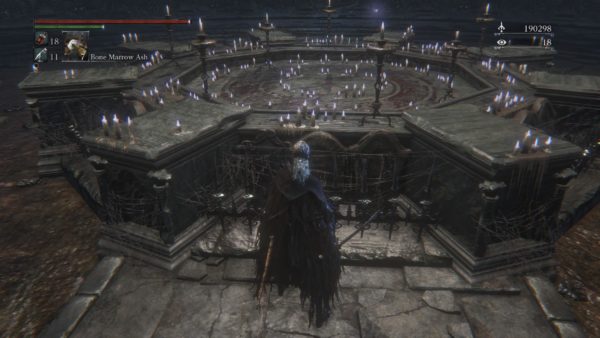
what little we know of pthumerian culture we must glean from what we find in the chalice dungeons ourselves. their aristocracy wears red, they have the ability to spontaneously generate controllable flames, and their weapons are based on the real life meteoric iron swords from indonesia, the kris. fire paper is a pthumerian invention (obtainable by the player only after they obtain a badge for tomb prospectors) that allows the user to create a flame from nothing. the only enemies that drop this item are pthumerian labyrinth watchers who use flaming weapons themselves.
the serpentine shape of the weapons might be more than mere aesthetics: there are a scant few references to snakes (one of the fromsoft dev teams favorite creatures to fixate on) in a religious or elevated context in pthumerian culture.a “pilgrim” who traverses the remains of pthumeru in the modern day carries a rosary with a caduceus in place of a crucifix.
but THIS queenly blood is NOT queen yharnam’s queenly blood. yharnam’s blood is a red, rapid, dirty poison.

 when the player arrives in the ruins of this civilization, evidence strongly suggests that a civil war broke out between at least two factions. the resulting schism pushed some pthumerian aristocracy to the surface3. here, they resumed their rule over their loyal subjects and became the modern day, blue-clad royalty of cainhurst castle. the evidence for the cainhurst/pthumeru connection is strong: living and hostile cainhurst knights with more modern armor can be found in the lowest levels of the pthumerian labyrinth. bloodlickers, a mosquito-like enemy that is exclusively found in cainhurst above ground, can be coerced from their hiding places in the chalice dungeons by performing visceral attacks and leaving blood splattered on the ground4. small, gold statues identical to the large, marble ones in cainhurst can be found in treasure rooms.
when the player arrives in the ruins of this civilization, evidence strongly suggests that a civil war broke out between at least two factions. the resulting schism pushed some pthumerian aristocracy to the surface3. here, they resumed their rule over their loyal subjects and became the modern day, blue-clad royalty of cainhurst castle. the evidence for the cainhurst/pthumeru connection is strong: living and hostile cainhurst knights with more modern armor can be found in the lowest levels of the pthumerian labyrinth. bloodlickers, a mosquito-like enemy that is exclusively found in cainhurst above ground, can be coerced from their hiding places in the chalice dungeons by performing visceral attacks and leaving blood splattered on the ground4. small, gold statues identical to the large, marble ones in cainhurst can be found in treasure rooms.
a collection of conspicuous portraits in cainhurst depicting the royal family and their knights and ladies includes a portrait of a bell-ringing “mad pthumerian” of the labyrinth, as well as a portrait of a man with the face of the cainhurst/pthumerian labyrinth exclusive enemy “the lost child of antiquity“5. the antiquated armor (old enough to be one of the few outfits unavailable to the player) worn by the man in the portrait can be found en masse scattered on the ground of specific chalice dungeon rooms. the skeletons of the pthumerians who once occupied this armor can be found piled into disrespectful heaps pierced by a labyrinth warrior’s great sword.
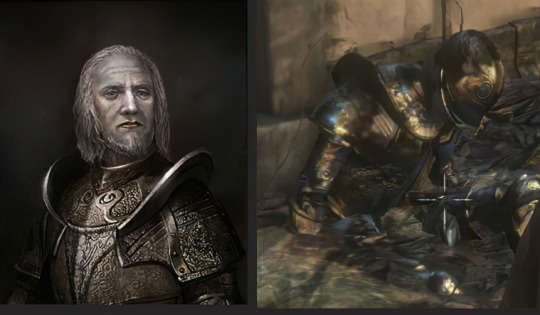 bloodborne is a game about dichotomies and divergent evolutions and, perhaps, the first true split began here: the cainhurst royalty and the pthumerian royalty BOTH aspire to have the mysterious and presumably powerful child of blood as a surrogate for a great one and both have knights in their employ that work explicitly to further this goal, putting them at odds with one another. today’s cainhurst royalty maintains some of the “pthumerian look” but not to such an exaggerated degree, with the resemblance fading with each removed generation.
bloodborne is a game about dichotomies and divergent evolutions and, perhaps, the first true split began here: the cainhurst royalty and the pthumerian royalty BOTH aspire to have the mysterious and presumably powerful child of blood as a surrogate for a great one and both have knights in their employ that work explicitly to further this goal, putting them at odds with one another. today’s cainhurst royalty maintains some of the “pthumerian look” but not to such an exaggerated degree, with the resemblance fading with each removed generation.
pictured are some canonical cainhurst royalty and their descendants in order of relation from left to right: annalise, queen of the “vilebloods” of forsaken castle cainhurst (top left), lady maria (top middle, a cainhurst knight and “distant relative of the queen”), arianna, woman of pleasure (right; she is also the most distant descendant and prostitute. her clothing identifies her as nobility but she makes no mention of her relation to the castle whatsoever, unless you count telling a female hunter that she “doesn’t want to drag them down too”.). the bottom image is concept art of lady maria during her boss fight with a more exaggerated look that did not make it into the game.

i’m inclined to learn toward believing that yahar’gul, unseen village and hemwick charnel lane were late pthumerian settlements on the surface in service of cainhurst. this is based on the enormous sizes of the corpses in yahar’gul, the appearance of chalice dungeon pthumerians and creatures occupying the hidden city, and the sheer size of the hemwick grave women. though it can be hard to see due to all the murdering you that they’re trying to do, they too are slack–jawed, thin, and pretty pale. there’s other things that only become apparent by the time the hunter comes to visit, so we’ll hold out until then.
pthumeru, and its sister cities isz and loran, rose, peaked, and died leaving behind shambling corpses of the cities they once were. though they were always a civilization of catacombs, bones, and blood, each area developed a difference single minded fascination that drove them to ruin. the careless indulgence of the blood, the maddening need to understand the cosmic, and the self-deterministic fall into savagery would all play out again in the far, far future. we are entering a cycle of stagnation. and with stagnation, fromsoft wants to hammer home to the player in every single game, comes rot.
anyway: a bazillion years later or whatever. the cainhurst royals rule over a land that includes the victorian england-ish city of yharnam, named for the forgotten queen of pthumeru (this city has become “old yharnam” by time the player arrives). the main appeal of yharnam is its proximity to a university of bold, weird research. i don’t know if it was before or after the establishment of the school, but i think yet another meteorite crashed into yharnam, opening a hole into the dungeons for the first time in who knows how long, delivering magnetic iron to the yharnamites, and introducing the hapless dopes to the cosmic for the first time. in fact, maybe more than one fell; there are a few locations in yharnam that are strange and hint at a direct proximity to the chalice dungeons. we’ll talk about it as we get there. for now, let’s stick to the lakeside university of questionable science.
the school of byrgenwerth and its scholars were once an archeological and historical research center headed by an older scholar by the name of provost willem. during the course of their studies, either by happenstance or the aforementioned meteorological event, they discovered the pthumerian labyrinths. i believe the progression that the hunter makes in the dungeons is intended to mirror the original excavation and exploration of the tombs, meaning that that byrgenwerth, much like the player character, began their journey on the outer edges of the pthumerian civilization/tomb of the gods.
 if true, then their experience must have been as confounding as it is to the player. they would have encountered the ancient pthumerians in a desiccated state, witch-y women with the ability to re-animate corpses, and, most intriguing of all, a bizarre flora/fauna creature that defied all understanding. this alien looking creature is something special, a class of creature called “kin” that can, in ways not yet known to the scholars, tap into the arcane cosmos. this can be experienced first hand by the player when, upon death, the creature sucks itself into a cosmic wormhole leaving behind its titular glowing flower and a small, vestigial chunk of its body. this flower appears to be the reason why these creatures can be found reliably in the large, oddly lush and well maintained gardens of the dungeons. in the concept art, the flower has a much more distinctive twist, making it the first known indicator of anti-clockwise metamorphosis. just pin that, for now.
if true, then their experience must have been as confounding as it is to the player. they would have encountered the ancient pthumerians in a desiccated state, witch-y women with the ability to re-animate corpses, and, most intriguing of all, a bizarre flora/fauna creature that defied all understanding. this alien looking creature is something special, a class of creature called “kin” that can, in ways not yet known to the scholars, tap into the arcane cosmos. this can be experienced first hand by the player when, upon death, the creature sucks itself into a cosmic wormhole leaving behind its titular glowing flower and a small, vestigial chunk of its body. this flower appears to be the reason why these creatures can be found reliably in the large, oddly lush and well maintained gardens of the dungeons. in the concept art, the flower has a much more distinctive twist, making it the first known indicator of anti-clockwise metamorphosis. just pin that, for now.
the floral creature also leaves behind smatterings of a precious material called “arcane haze”. but…mysteriously, ONLY the creatures being maintained in the underground gardens drop this precious resource. the sole example found outside of the dungeons, wandering the grounds of byrgenwerth aimlessly, does not.
some things only grow in the labyrinth.
the true treasure of the labyrinths, however, was not flowers or gold, but blood.
further investigation by byrgenwerth revealed an unspecified “holy medium” that would spark a pathological fascination with the ruins: a substance called ritual blood, which does not coagulate. there is ritual blood of a presumed similar quality on an altar found near the church of the good chalice, but obviously is not THE exact same ritual blood sample from this specific expedition. i believe the player was intended to intuit the connections between the ritual blood, pthumeru and byrgenwerth by introducing these new concepts one after another during a conventional playthrough. after you first read the word “byrgenwerth” and are able to ask about it, you are then instructed by an npc to fetch the pthumeru chalice (and, coincidentally, will stumble on the ritual blood needed to satiate the chalice along the way).
critically, i do not think the first encounter with “the old blood” was from an exotic source; like most ritual blood in the game, it was likely discovered in an ornate coffin housing a pthumerian corpse. while “a blood that never hardens” may not be a bombastic discovery compared to “a blood that twists you into a fucked up creature and gives you super powers”, all of the subtext in the game suggests that trying to understand the mystery of the blood was a process that took years of experimentation and countless lives. surely, as a bloodborne lore junkie/fan/casual knowledge seeker you can intuitively understand the allure of incremental discovery that drove the slow downfall of the byrgenwerth scholars? is there no moment more satisfactory than the singular internal emotional rush that comes with truly, deeply understanding even just one sliver of a mystery?
unfortunately, there was a little bit of a snag: attempts to dig into the next layer of the labyrinth (central pthumeru) were halted by the aforementioned fucked up creature with superpowers; the first encounter with a beast. this was a significant moment in yharnam history. not just because it lead to the transcription of the first6 caryll rune, but because of the implications of the discovery that failed to impress on the scholars: “The discovery of blood entailed the discovery of undesirable beasts”. that is to say: where you find blood, you will find beasts. where you take blood, beasts will follow.
okay, fine. there’s nothing canon that says it was SPECIFICALLY the beast-possessed soul (BPS) in the labyrinth. we’ve been heavy with the italics this whole section. but it’s strongly implied and most of yharnam history is intentionally obscure, leaving much to the reader imagination. just bear with me.
i believe the BPS was once a labyrinth ritekeeper turned by the scourge, which would have made it the first (unwitting) known example of a cleric beast. if we consider the similarity in height (when the ritekeepers stand), the canon knowledge that individuals with close proximity to religion (as in loran as well) transform into their own unique horned monstrosities, and that the fire throwing ability used by the BPS is unique to pthumerians, it doesn’t seem completely implausible. if you really want to get nitty-gritty into this theory, the BPS also has pale, white skin under its fur, black nails, a slender figure, and an open, gaping mouth (er, muzzle). but the question remains: for what purpose would this introduction to this concept serve at this point in the narrative/game-play?
believe the BPS was once a labyrinth ritekeeper turned by the scourge, which would have made it the first (unwitting) known example of a cleric beast. if we consider the similarity in height (when the ritekeepers stand), the canon knowledge that individuals with close proximity to religion (as in loran as well) transform into their own unique horned monstrosities, and that the fire throwing ability used by the BPS is unique to pthumerians, it doesn’t seem completely implausible. if you really want to get nitty-gritty into this theory, the BPS also has pale, white skin under its fur, black nails, a slender figure, and an open, gaping mouth (er, muzzle). but the question remains: for what purpose would this introduction to this concept serve at this point in the narrative/game-play?
if byrgenwerth followed the same or similar progression we do into the dungeons, they would have encountered BPS on the first layer of the central pthumeru chalice dungeon after exploring the entirety of the topmost pthumerian labyrinth. by now, the player would have almost certainly been introduced to at least one cleric-type beast explicitly labeled as such and encountered multiple references to the cleric beat phenomenon in item descriptions. consequently the player would, eventually, be intended to realize the significance of the horns on this new specimen. in my proposed timeline, the byrgenwerth scholars would have no knowledge of this facet of beasthood until it was too late. instead, this moment would spur one byrgenwerth scholar named caryll to begin to transcribe “inhuman sounds” in symbols and “beast”, a product of this unique encounter, became the first caryll rune. the only BPS outside of the chalice dungeons7 that the hunter will encounter drops this rune. it’s his roar after all.
consequently, once the power of this rune became realized, it was one of the first to become banned. in another, related rune, caryll elaborated that “beast” is a “horrific and unwelcome instinct deep within the hearts of men” but leaves the reader to infer what that instinct might be. the characters belonging to institutions that shunned beasthood became the birthplace of twisted and malformed monstrosities…yet, there are a handful of yharnamite beasts who were eager to indulge in what the scourge offered them whose transformations were far less dramatic, perhaps even enviable. one could conclude that beasthood is much more forgiving to those who accept it, BPS included. what role this deliberate beast played in pthumerian society is not immediately clear, especially as the number of beasts remaining in the entirety of pthumeru can be counted on two hands.
so what to do about undesirable beasts?
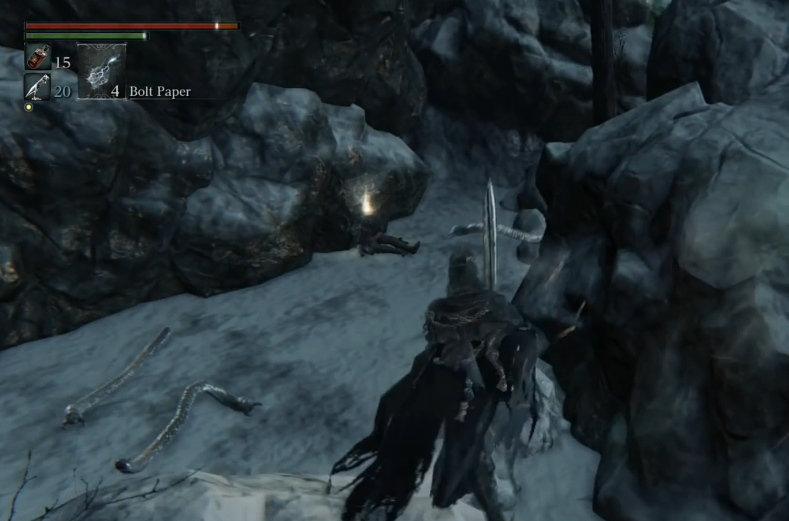 of course, cainhurst already knew all about this dog blood bullshit. the royals were described as “long time imbibers of blood” in an item description of a weapon that has been around long enough to inspire other, shittier hunter weapons by the time you arrive on the scene. they already have a special class of servants (knights) who take care of any signs of beasthood bubbling up under their ranks with discretion. closer inspection of the kn ight’s garb reveals a blood red gemstone8 sewn into the cravat revealing cainhurst already had access to something the rest of yharnam was only beginning to discover: blood gems, little crystals that could be used to imbue weapons with greater power. whatever process causes the body to produce blood gems after death occurs nearly entirely in the chalice dungeons; there are hardly any blood gems to be found in the over-world. blood gems become stronger the deeper one heads into the labyrinth, terminating at “abyssal” blood gems.
of course, cainhurst already knew all about this dog blood bullshit. the royals were described as “long time imbibers of blood” in an item description of a weapon that has been around long enough to inspire other, shittier hunter weapons by the time you arrive on the scene. they already have a special class of servants (knights) who take care of any signs of beasthood bubbling up under their ranks with discretion. closer inspection of the kn ight’s garb reveals a blood red gemstone8 sewn into the cravat revealing cainhurst already had access to something the rest of yharnam was only beginning to discover: blood gems, little crystals that could be used to imbue weapons with greater power. whatever process causes the body to produce blood gems after death occurs nearly entirely in the chalice dungeons; there are hardly any blood gems to be found in the over-world. blood gems become stronger the deeper one heads into the labyrinth, terminating at “abyssal” blood gems.
cainhurst’s access to the dungeons might be in plain sight; there’s a weird valley at the entrance of the cainhurst map full of the worst enemy ever in the world, parasite larva, that dead ends in a strange way; its like a cave that collapsed. at its entrance is a corpse with a (unremarkable) blood gem to loot. perhaps this was once the entrance used to access pthumeru for blood and trinkets (and 8000000 statues, apparently), as evidenced by this body that has developed a weak blood gem from having died so close to the tombs. or maybe its just the royal worm pit. for the worms.
 the miraculous abilities of the “old blood” in the labyrinth became the subject of fascination and research at byrgenwerth. at this point in time, the student body was appropriately wary of the substance. the overwhelming and horrific thirst for blood in pthumerian society is hard to ignore when there are corpses stacked haphazardly in enormous pools of stagnant red slime and rooms where exsanguinated bodies still hang from the ceiling in a loose pose that clearly evokes the “dangling, upside-down” nature of the hunter’s rune. this symbol from pthumerian society is a depiction of a body in the process of exsanguination. the quickest way to exsanguinate something is to cut a large artery, flip it, and let gravity take over. butchery 101.
the miraculous abilities of the “old blood” in the labyrinth became the subject of fascination and research at byrgenwerth. at this point in time, the student body was appropriately wary of the substance. the overwhelming and horrific thirst for blood in pthumerian society is hard to ignore when there are corpses stacked haphazardly in enormous pools of stagnant red slime and rooms where exsanguinated bodies still hang from the ceiling in a loose pose that clearly evokes the “dangling, upside-down” nature of the hunter’s rune. this symbol from pthumerian society is a depiction of a body in the process of exsanguination. the quickest way to exsanguinate something is to cut a large artery, flip it, and let gravity take over. butchery 101.
its unclear if byrgenwerth was responsible for some/all of the central pthumeru bloodlettings or if they just learned the technique here. the potential benefits of collecting blood lead to the earliest incarnations of “hunters” as we know them. this rune would eventually be branded in the mind of anyone who “signs a contract” to become a hunter. if you think about it too hard you die and lose all of your blood (echoes). like when i try to do math.
1. the re-translation project’s re-translation of the pthumeru ihyll chalice item description states that the name “yharnam” is inherited by each queen.
2. source
3. the translated names at the bottom of this page identifies the rooms with empty cainhurst armors (number 10 in the list, arena) as “remains of a battlefield site”. this is literally the only interesting fact about chalice dungeon room names.
4. source
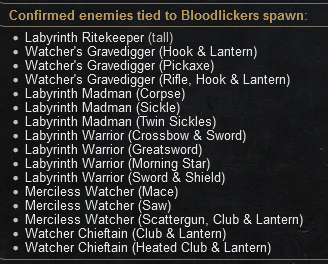
5. a rare, truly lousy translation. should be “bastard of cainhurst” (imo). as in the most dictionary definition sense of the word bastard as a child out of wedlock. the re-translation suggests “ancient bastard”.
6. the english release says “one of the first” but the japanese is more direct: it’s the first official rune that caryll transcribed. “hunter” and the hunter’s mark may have been grandfathered in as such later. or not. what do i know.
7. this didn’t fit well, but the BPS is an extremely odd character/creature and the game goes through great pains to demonstrate this. it appears only three times in the game and the story chalice dungeons: once in yharnam, once in central pthumeru as the first layer boss, and once in ailing loran as the first layer boss. that’s it.
BUT: using root chalices, there is a chance to spawn a special BPS as a roaming encounter who attacks not only you but other enemies as well. it can be healed with an item used to heal co-operators.
8. this item is not found in cainhurst in the released game, but its location in game files indicates it should have been.

